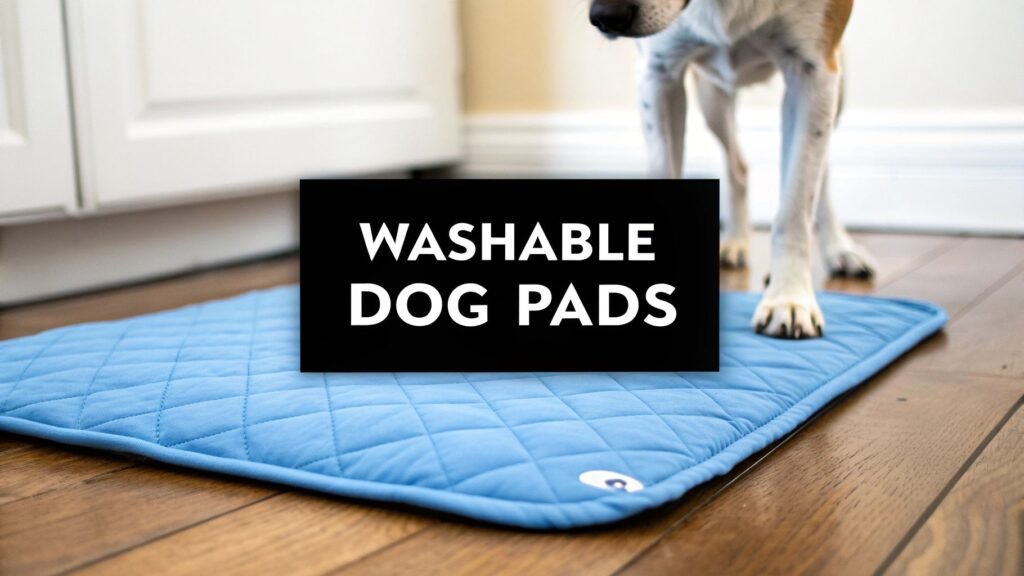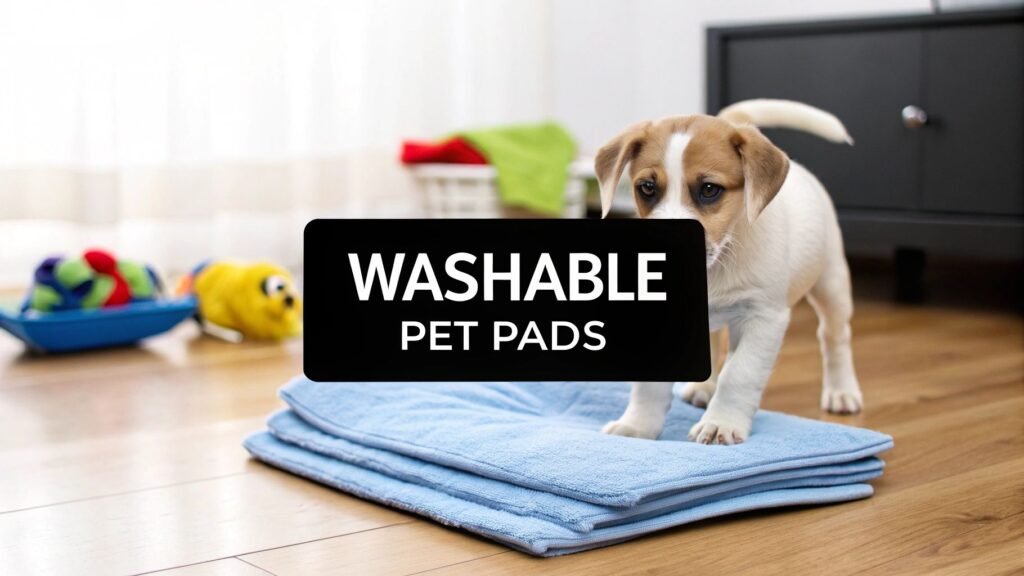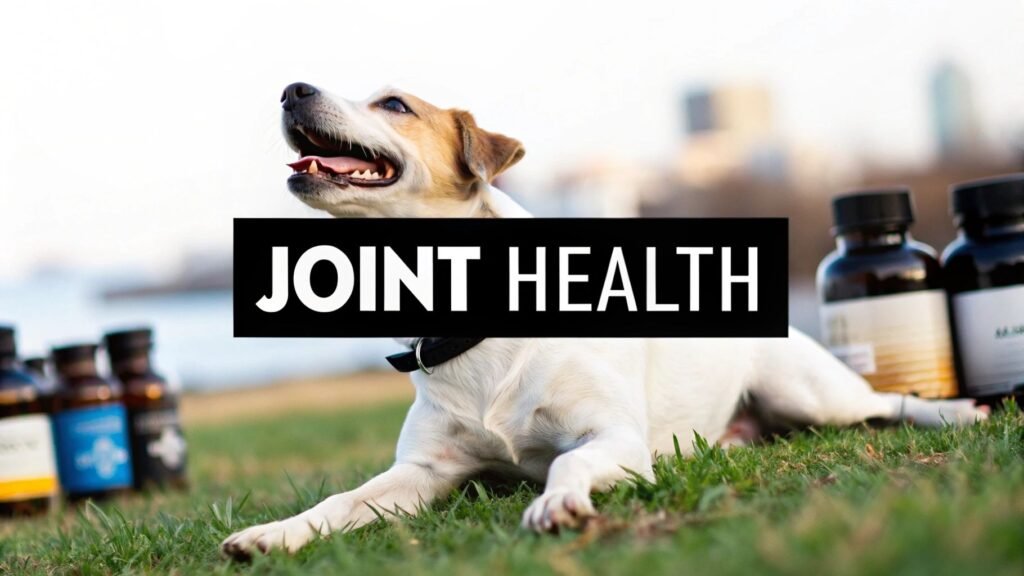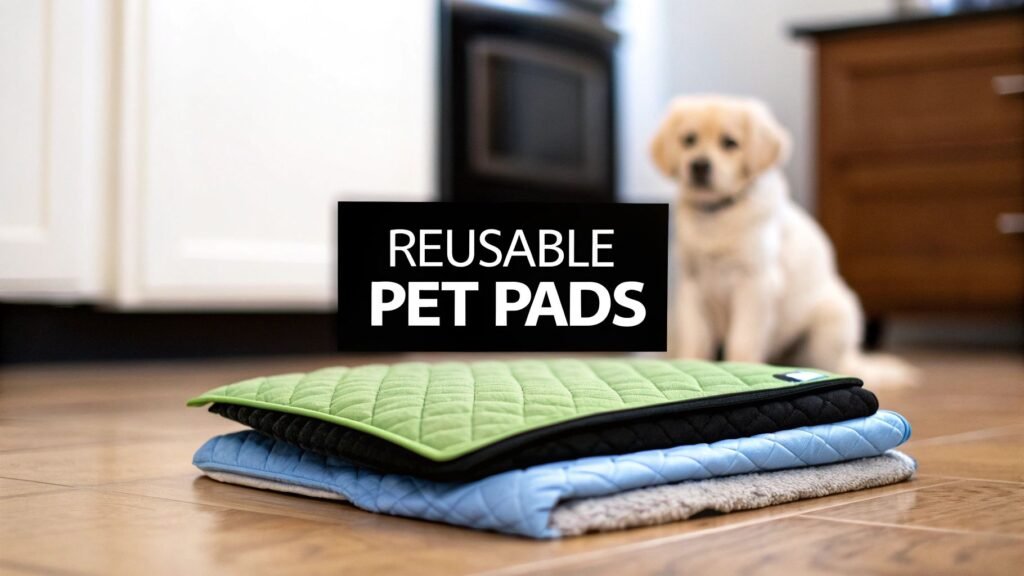A Pet Owner’s Guide to Washable Pee Pads
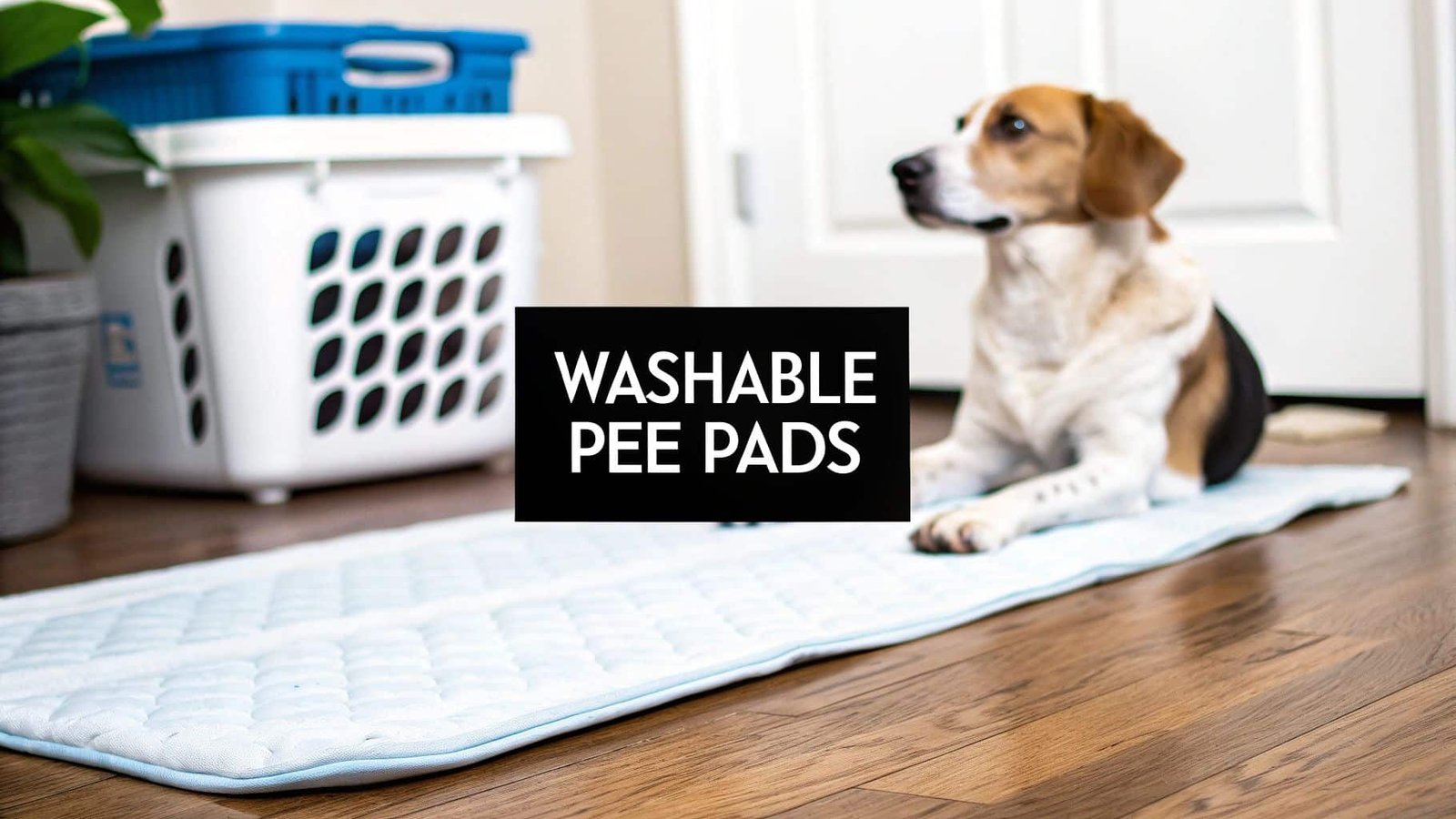
Tired of constantly buying and throwing away disposable pee pads? If you’re a pet owner, you know the routine. Washable pee pads offer a smarter way forward—a cost-effective and eco-friendly alternative that’s a one-time investment for your home’s protection and your pet’s comfort.
The Smart Shift to Reusable Pet Pads
Bringing home a new puppy or caring for an older dog often means dealing with a mountain of trash. You buy a pack of disposable pads, use them once, and toss them out. Day after day. This isn’t just hard on your wallet; it adds up to a lot of landfill waste. Washable pee pads offer a welcome escape from that endless cycle.
Think of it like this: you wouldn’t use a paper towel to do the job of a high-quality bath towel. The paper towel is a one-and-done solution. The bath towel, on the other hand, is built for performance and repeated use, getting the job done wash after wash. That’s the real difference here. A well-made washable pad is engineered with multiple layers designed to trap liquid, lock in odors, and protect your floors. After it’s used, a simple trip through the washing machine makes it good as new.
A Clearer Choice for Pet Owners
Switching to washable pads is about more than just being green—it’s about choosing a more reliable and effective tool for your pet’s needs. Yes, the initial cost is higher, but the savings add up quickly when you stop buying disposable packs every month. This move is part of a bigger trend in pet care, where owners are prioritizing quality and sustainability. For a deeper dive, check out our complete comparison of reusable dog pee pads vs disposable options.
The numbers back this up. While an estimated 4.6 billion disposable pee pads are made each year, the market for washable alternatives is growing fast. This trend is especially strong in North America and Europe, where pet owners are looking for durable, long-term solutions that make sense for both their budget and the planet.
The core idea is simple: invest once in a high-quality product that lasts for years, rather than repeatedly spending on a temporary fix. This approach not only saves money but also provides a more comfortable and hygienic surface for your beloved pet.
To really see the difference, it helps to put them side-by-side.
Washable vs Disposable Pads: A Quick Comparison
This table gives you a clear, at-a-glance look at how washable and disposable pads stack up across the factors that matter most to pet owners.
| Feature | Washable Pee Pads | Disposable Pee Pads |
|---|---|---|
| Lifetime Cost | Higher upfront, significant long-term savings | Low initial cost, high recurring expense |
| Environmental Impact | Minimal waste, reusable for years | Contributes to landfill waste |
| Durability | Designed for hundreds of washes | Single-use, easily torn or shredded |
| Performance | Superior absorbency and odor control | Varies greatly, often leaks or slips |
| Comfort | Soft, cloth-like surface | Crinkly, plastic-like feel |
As you can see, washable pads come out ahead in nearly every category, offering a far better value over the life of your pet.

How a Quality Washable Pad Really Works
Ever looked at a washable pee pad and wondered how on earth it holds so much liquid without a single drop hitting your floor? It’s not magic, but it is some pretty smart fabric engineering. A good pad is essentially a high-performance sandwich, where each layer has a very specific job in keeping messes contained and your pet dry.
Getting to know this multi-layer system is what separates the pads that will last you for years from the ones that give up after just a handful of washes. Let’s pull back the curtain and see what makes a truly effective pad tick.
The Top Layer: All About Comfort
The first thing your pet feels is the soft, moisture-wicking top layer. This isn’t the crinkly, plastic-y surface of a disposable pad; it’s designed to feel more like a comfortable blanket. Its main job is to pull urine away from your pet’s body, and fast.
This quick-wicking action is what keeps your pet’s paws and fur from getting soaked. You’ll often find materials like fleece, flannel, or special polyester blends used here. They’re gentle on the skin but incredibly good at funneling liquid down into the core, away from the surface.
The Super-Absorbent Core: The Thirsty Middleman
Right below that comfy top layer is the real workhorse of the pad: the super-absorbent core. Think of it as a high-tech sponge designed to soak up liquid and lock it away for good.
This layer is usually made from a dense, thirsty material like a rayon/polyester blend or other specialized soaker fabrics. Some of the best pads even mix in things like bamboo charcoal for its natural odor-fighting abilities. A well-made core can hold several times its own weight in liquid, which is an absolute must for preventing leaks, especially for bigger dogs or overnight use.
This is where all those benefits of absorbency, cost-savings, and eco-friendliness really come together.

As you can see, it’s the combination of materials that delivers a pad that works well, saves money, and is better for the planet.
The Final Line of Defense: The Waterproof Backing
The bottom layer is your floor’s bodyguard. This is the waterproof, non-slip backing that makes sure nothing ever seeps through. It’s a complete barrier, sealing in all the liquid that the core has absorbed.
This critical layer is almost always made with a polyurethane (PU) laminate. PU is the go-to material because it’s 100% waterproof but also breathable, which helps cut down on mildew. Most importantly, it stays flexible and tough even after hundreds of trips through the washer and dryer—something cheap vinyl backings just can’t do without cracking and failing.
A strong, bonded polyurethane backing is the non-negotiable feature of a premium washable pee pad. Without it, the pad simply cannot deliver on its promise of leak-proof protection.
Many of the best pads also add non-slip grips to this bottom layer. You’ll see little silicone dots or a tacky coating that keeps the pad from sliding all over hardwood, tile, or laminate floors. This is a huge safety feature, especially for rowdy puppies or older dogs who might not be as steady on their feet.
When you put it all together, you get a sophisticated system where every part works together:
- Top Layer: Wicks moisture for a dry, comfy surface.
- Absorbent Core: Soaks up and traps liquid and odors.
- Waterproof Backing: Creates an impenetrable shield to protect your floors.
Once you understand how these layers work in concert, you can easily spot a pad that’s built for the long haul. It’s this smart design that makes them such a reliable and cost-effective solution for any pet owner.
Choosing the Right Pad for Your Dog’s Needs

Picking the right washable pee pad isn’t as simple as grabbing the first one you see. What works for a tiny Yorkie puppy in a city apartment is going to be completely different from what an aging, incontinent Golden Retriever needs in a big house. The secret to success is matching the pad to your dog’s unique situation.
If you think beyond the basic product description and consider your actual day-to-day life, you’ll find the perfect fit. This approach means you’re investing in a solution that genuinely works for you and your dog, saving you from a lot of frustration and keeping your home clean.
Matching Pad Size to Your Pet and Space
Size is the first thing everyone thinks about, but it’s not just about your dog’s breed. You have to consider how your dog actually uses the space. For instance, a dog who spins in circles before doing their business needs a much bigger landing strip than one who just squats on the spot.
As a rule of thumb, the pad should be big enough for your dog to comfortably walk on, turn around, and potty without a single paw stepping off the edge.
- Small Breeds (Chihuahua, Pomeranian): A smaller pad, maybe around 24×24 inches, usually does the trick. It handles their needs just fine and fits nicely into smaller living areas.
- Medium Breeds (Beagle, Cocker Spaniel): It’s wise to size up here. A medium or large pad, something like 36×48 inches, gives them plenty of room and protects more of your floor.
- Large Breeds (Labrador, German Shepherd): Go big or go home. For large dogs, you’ll want the biggest size you can find. Extra-large or even giant pads (72×72 inches) are perfect for lining crates, covering large swaths of floor, or for whelping boxes.
A little pro tip: it’s always better to go a bit too big than to end up too small. A larger pad gives you a bigger margin for error and dramatically cuts down on those messy near-misses.
How Much Absorbency Do You Really Need?
Not all pee pads are equally thirsty. The level of absorbency you need really comes down to your dog’s age and habits. A young puppy with a tiny bladder that needs emptying constantly has very different needs from a senior dog who might have larger but less frequent accidents.
Look closely at product descriptions to see how much liquid a pad can actually hold. Top-tier pads often boast they can hold up to 10 cups of liquid, thanks to a super-dense inner core. This kind of capacity is a lifesaver for overnight use or for days when you have to leave your dog alone for a few hours. For just light, everyday use, a standard-absorbency pad will likely be all you need.
There’s a good reason this market is booming. Recent analysis valued the washable pet pee pad industry at around USD 685 million, and it’s only expected to climb. This growth is largely fueled by pet owners in cities looking for convenient, hygienic solutions. The high-performance materials like microfiber and polyurethane are exactly what makes them so effective.
Essential Features That Make a Real Difference
Beyond size and absorbency, a few key details can make or break your experience with a washable pee pad. These are the features that separate a pretty good pad from a truly great one.
A non-slip backing is absolutely essential, especially if you have hard floors like tile, laminate, or wood. Look for pads that have those little silicone dots or a slightly tacky coating on the bottom. This keeps the pad from becoming a magic carpet every time your dog walks on it—a crucial safety feature for clumsy puppies and wobbly senior dogs.
Also, pay attention to the top layer. A quilted top isn’t just for looks; it helps pull moisture down into the core much faster, keeping the surface feeling drier for your dog’s paws. If your dog also likes to lounge on their pad, you can make it even more inviting by pairing it with other comfy bedding. For some great ideas, check out our guide to the best beds and mats for your dog.
Creative and Practical Uses Beyond Potty Training
While washable pee pads are absolute lifesavers for housebreaking, their job is far from over once your puppy is trained. Thinking of them only for potty training is like buying a top-of-the-line food processor just to make smoothies. You’re missing out!
Once you see how versatile these pads are, you’ll find they’re a must-have for every stage of your pet’s life. Their tough, absorbent, and waterproof design makes them the perfect fix for all sorts of everyday pet-related messes. Let’s dive into a few clever ways to put them to work.
An All-Purpose Liner for Crates and Carriers
Lining a crate or travel carrier with a soft pee pad makes it a much cozier and more secure space for your pet. A simple towel or blanket tends to bunch up and slide around, but a quality washable pad with a non-slip backing stays right where you put it.
This gives your dog a comfy, cushioned spot to relax on car rides or while kenneled. More importantly, it’s your first line of defense against accidents. Whether it’s a nervous tinkle on the way to the vet or a spilled water bowl, the pad’s waterproof layer keeps the carrier pristine, which makes cleanup so much easier.
The Ultimate Food and Water Station Mat
Do you have a messy eater or a splashy drinker on your hands? Placing a washable pad under their food and water bowls is a genius trick for containing the chaos. Spilled kibble and water droplets get trapped on the pad instead of seeping into your floors.
This little hack is fantastic for protecting your hardwood or laminate from water damage and keeping the whole feeding area more hygienic. When it gets grubby, just pick it up, shake it out over the trash, and toss it in the wash. It beats mopping up a grimy, sticky floor any day.
Think of a washable pee pad as a portable, all-purpose protection shield for your home and vehicle. Wherever your pet goes, a pad can provide a clean, dry, and comfortable surface while safeguarding your belongings.
A Seat Protector for Stress-Free Travel
Taking your dog for a ride shouldn’t mean sacrificing your car’s interior. A large washable pad works wonders as a seat cover, protecting your upholstery from muddy paws, shedding fur, and the occasional “oops.”
Just lay one across the back seat or cargo area before your dog hops in. The absorbent top layer and waterproof backing make sure that dirt, moisture, and hair stay on the pad, not on your seats. When you get home, the pad goes straight into the laundry, and your car is left looking clean and smelling fresh for the next trip.
A Comfortable and Hygienic Whelping Mat
For breeders or anyone with an expecting dog, washable pads are an absolute game-changer for the whelping box. They create a soft, warm, and super-absorbent surface that helps keep newborn puppies clean, dry, and safe.
Because they’re so durable, you can change and wash them frequently—a critical step for maintaining a sanitary environment during the puppies’ vulnerable first few weeks. Many people layer a few pads and simply peel off the top one as it gets soiled, making for a quick and easy swap. This one use alone proves just how valuable and reliable a good set of washable pee pads can be.
Your Guide to Easy Cleaning and Long-Term Care

When people first consider switching to reusable pads, the same question always comes up: “Aren’t they a huge pain to clean?” I get it. But honestly, keeping washable pee pads fresh and hygienic is a lot simpler than you might think.
With just a little routine, you can keep them in top shape for hundreds of washes. This isn’t about some complicated cleaning ritual; it’s about a few smart habits that protect the pad’s layers and ensure it stays absorbent and odor-free for years.
The Simple Pre-Wash Routine
What you do before the pad hits the washing machine can make all the difference. If there’s solid waste, just pick it up and dispose of it like you always do. Easy.
For pads that are just wet, you have a couple of options. You can give them a quick rinse under a tap in a utility sink or spray them down with a hose outside. This isn’t a mandatory step, but it does help wash away a good amount of the urine before it goes into your machine. Alternatively, many people just shake them out and toss them into a dedicated waterproof hamper until laundry day.
Mastering the Machine Wash
This is where the magic happens. Washing the pads correctly is the key to their longevity. Your goal is simple: get them thoroughly clean without damaging the absorbent core or the waterproof backing.
Here’s the proven, no-fuss method I recommend:
- Use Warm Water: Stick to a warm, not hot, cycle. It’s the perfect temperature to kill bacteria and dissolve urine crystals without being harsh enough to damage the delicate waterproof layer.
- Choose a Regular Cycle: No need for a heavy-duty setting. A standard wash cycle has plenty of power to get the job done while being gentle on the fabric.
- Pick a Mild Detergent: A simple detergent without a lot of dyes or perfumes is your best bet. While most big brands work, a pet-safe formula is always a great choice.
Crucial Care Tip: Whatever you do, never use fabric softener or dryer sheets. These products are the kryptonite of absorbent fabrics. They leave a waxy film that clogs the material’s pores, killing its ability to soak up liquid. It’s like trying to dry yourself with a towel that’s been coated in wax—it just won’t work.
On that same note, stay away from chlorine bleach. It’s way too aggressive and can eat away at the waterproof backing over time, which will eventually cause leaks.
Tackling Stubborn Odors and Stains
Even with perfect washing habits, you might notice a faint ammonia smell pop up now and then, especially with older pads. This is usually just a bit of detergent or mineral buildup trapping bacteria. Don’t sweat it; it’s an easy fix.
- The White Vinegar Trick: Just add a cup of plain white vinegar to the rinse cycle. Vinegar is a natural deodorizer that cuts right through that buildup, knocking out the source of the smell without harming the pad.
- Bring in the Enzymes: For really stubborn odors, an enzymatic cleaner is the ultimate weapon. These products use natural enzymes to literally break down and consume the organic proteins in urine, completely eliminating the smell instead of just covering it up. You can check out some great options in our grooming and cleaning section.
It’s no surprise that the demand for these kinds of easy-to-care-for pet products is exploding. The washable pee pad market hit around USD 245 million recently and is on track to reach USD 412 million by 2033. This surge is all thanks to pet owners like us who want sustainable, hygienic solutions. You can dive deeper into this growing market on reportprime.com.
Drying for Durability
How you dry your pads is just as important as how you wash them. To really get the most life out of them, air-drying is the gold standard. Toss them over a clothesline or a drying rack, and you’re good to go. They’re designed to dry pretty quickly on their own.
If you absolutely must use a machine, be sure to tumble dry on a low-heat or no-heat setting. High heat is the enemy of the waterproof backing; it can cause it to warp, crack, or even melt over time, leading to leaks. A little patience during drying will pay off big time in the long run.
Got Questions About Washable Pee Pads? Let’s Talk.
Switching to a new product always brings up a few questions. Even after you’ve got the basics down, you might still have some nagging “what ifs” before you’m ready to dive in. That’s completely normal.
Think of this as the final chat over the fence with a neighbor who’s been using these for years. We’ll tackle the most common questions people have about washable pee pads, clearing up any doubts so you can feel confident you’re making a great choice for your pet and your home.
How Many Washable Pads Do I Actually Need?
This is the big one, and thankfully, the answer is simple. While you could technically survive with just one, life gets a whole lot easier when you have a small rotation.
The magic number for most pet parents is three. It’s a foolproof system that means you’re never caught off guard.
- One in use: This is the pad on the floor, doing its job.
- One in the wash: The soiled pad, getting clean.
- One ready to go: A fresh, dry pad waiting in the closet for its turn.
With this “one down, one dirty, one ready” method, there’s zero laundry-day panic. You can swap out a used pad instantly without staring at the washing machine, waiting for the cycle to end. If you have multiple dogs or need pads in a few different spots, just scale the formula up.
Seriously, Will These Pads Leak All Over My Floor?
Absolutely not—as long as you invest in a quality pad. A washable pad’s ability to protect your floors comes down to one thing: its waterproof backing. The best pads use a tough polyurethane (PU) layer as the final line of defense. This material is 100% waterproof and is permanently bonded to the absorbent layers above it, creating a barrier that liquids just can’t get through.
Here’s a pro tip: Steer clear of cheap pads with flimsy vinyl backing. Vinyl feels waterproof at first, but it gets brittle and cracks after just a few washes. Before you know it, you’ve got leaks. A solid PU backing, on the other hand, is built to take hundreds of trips through the washer and dryer without breaking a sweat.
So, yes, a well-made pad will keep your floors perfectly dry. The trick is to look for one with that durable, reliable waterproof layer that’s in it for the long haul.
How Do I Convince My Dog to Use the New Pad?
Getting your dog to switch from disposable pads—or to use a pad for the very first time—is all about patience and making it a positive experience. Dogs can be a little suspicious of new textures and smells, so your job is to show them that this new pad is the best spot in the house.
First things first: place the new washable pad in the exact same spot the old disposable one lived. Dogs are creatures of habit, so consistency is key.
From there, lean on these simple training steps:
- Make a Great First Impression: When you lay the pad down, bring your dog over. Let them sniff it and walk on it. Use a happy, encouraging voice and give them a treat just for checking it out. You’re building a good vibe right from the start.
- Use Their Scent: If you’re switching from disposables, take a lightly used one and gently dab it on the center of the new washable pad. That familiar smell is like a signpost that says, “This is the right place to go!”
- Reward Success Instantly: The second you see your dog use the pad correctly, celebrate! Lavish them with praise, pets, and a really good treat. That immediate reward forges a powerful connection in their mind.
- Never Punish Accidents: If an accident happens somewhere else, don’t scold them. It only creates fear, which kills any training progress. Just clean it up with an enzymatic cleaner (this is crucial for removing scent cues) and move on.
By making the pad a place where great things happen, your dog will quickly learn that using it is the best decision they can make.
Won’t a Reusable Pee Pad Make My House Smell?
This is a huge worry for many people, but with proper care, it’s a total non-issue. A well-designed pad is made to fight odors. Many incorporate materials like bamboo charcoal right into the absorbent core, which naturally traps and neutralizes smelly bacteria.
But the real secret weapon is your laundry routine. Washing the pads regularly in warm water with a quality detergent is usually all it takes to keep them smelling fresh. If you ever notice a faint ammonia smell starting to build up over time, there’s an easy fix. Just add a cup of plain white vinegar to your washer’s rinse cycle. The vinegar effortlessly breaks down any residue that might be trapping odors, leaving the pad completely fresh.
Ready to make the switch to a smarter, more sustainable solution? Explore the full range of durable and super-absorbent Ur Pet Store washable pads today and discover a better way to keep your home clean and your pet happy.


